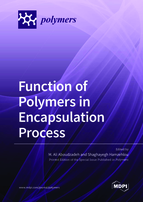Function of Polymers in Encapsulation Process
A special issue of Polymers (ISSN 2073-4360). This special issue belongs to the section "Polymer Processing and Engineering".
Deadline for manuscript submissions: closed (31 December 2021) | Viewed by 38196
Special Issue Editors
2. Donostia International Physics Center (DIPC), Paseo Manuel Lardizábal 4, 20018 Donostia-San Sebastián, Spain
Interests: polymer synthesis and characterization; supramolecular assemblies; rheology; DNA nanotechnology; encapsulation via emulsion-based systems; polymer hybrid materials
Special Issues, Collections and Topics in MDPI journals
Interests: polymer reaction engineering; modelling and simulation of kinetics, topology, microstructure and morphology of the complex polymerization systems; emulsion polymerization; polymer synthesis and characterization
Special Issue Information
Dear Colleagues,
Encapsulation technology consists of surrounding active agents within a homogeneous/heterogeneous matrix at the micro/nano scale. Using this technology, a physical barrier is developed between the inner substance and the environment which prevents its degradation and facilitates its handling and transportation. Polymers may be used to trap the material of interest inside the micro/nano-capsules. Such encapsulated systems have many applications in the fields of food industry, drug delivery, agriculture, cosmetics, coatings, adhesives and so forth. There are a number of chemical, physical or mechanical processes available for encapsulation such as emulsion-solvent evaporation/extraction methods, coacervation-phase separation, spray drying, interfacial and in situ polymerization. The choice of a particular technique depends on the attributes of the polymer and the active agent. There are still many aspects to be developed in this field, which offer new challenges and breakthrough opportunities. The main objective of this interdisciplinary Special Issue is to bring together, at an international level, a high-quality collection of reviews, original articles and short communications dealing with the importance of natural or synthetic polymers in encapsulation processes and their applications.
We review all the articles in our Special Issue, and we believe this editorial will interest the broadest possible section of readership among materials scientists and engineers.
Dr. M. Ali Aboudzadeh
Dr. Shaghayegh Hamzehlou
Guest Editors
Manuscript Submission Information
Manuscripts should be submitted online at www.mdpi.com by registering and logging in to this website. Once you are registered, click here to go to the submission form. Manuscripts can be submitted until the deadline. All submissions that pass pre-check are peer-reviewed. Accepted papers will be published continuously in the journal (as soon as accepted) and will be listed together on the special issue website. Research articles, review articles as well as short communications are invited. For planned papers, a title and short abstract (about 100 words) can be sent to the Editorial Office for announcement on this website.
Submitted manuscripts should not have been published previously, nor be under consideration for publication elsewhere (except conference proceedings papers). All manuscripts are thoroughly refereed through a single-blind peer-review process. A guide for authors and other relevant information for submission of manuscripts is available on the Instructions for Authors page. Polymers is an international peer-reviewed open access semimonthly journal published by MDPI.
Please visit the Instructions for Authors page before submitting a manuscript. The Article Processing Charge (APC) for publication in this open access journal is 2700 CHF (Swiss Francs). Submitted papers should be well formatted and use good English. Authors may use MDPI's English editing service prior to publication or during author revisions.
Keywords
- encapsulation technology
- drug delivery
- nanoparticles
- nanocapsules
- microcapsules
- biodegradable polymers
- emulsion polymerization
- biomedical applications
- spray-drying
- biomaterials








